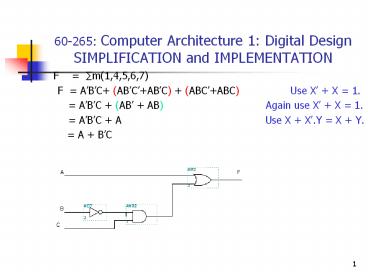60-265:%20Computer%20Architecture%201:%20Digital%20Design%20SIMPLIFICATION%20and%20IMPLEMENTATION PowerPoint PPT Presentation
Title: 60-265:%20Computer%20Architecture%201:%20Digital%20Design%20SIMPLIFICATION%20and%20IMPLEMENTATION
1
60-265 Computer Architecture 1 Digital
DesignSIMPLIFICATION and IMPLEMENTATION
- F ?m(1,4,5,6,7)
- F ABC (ABCABC) (ABCABC)
Use X X 1. - ABC (AB AB)
Again use X X 1. - ABC A
Use X X.Y X Y. - A BC
2
Implementation of Inverter/AND/OR
using NAND gates only
- Inverter using NAND
- AND using NAND
- OR using NAND
3
IMPLEMENTATION of F A BC using
NAND gates only
- To implement the previous simplified function by
using NAND gates only - X NAND Y (X.Y)
- F (A B.C)
- ( (A B.C) )
- (A.(B.C))
4
Implementation of Inverter/AND/OR
using NOR gates only
- Inverter using NOR
- AND using NOR
- OR using NOR
5
IMPLEMENTATION of F A BC
using NOR gates only
- To implement the same function by using NOR gates
only X NOR Y (X Y) - F (A BC)
- ((A (BC)))
- ((A (BC) )) ((A P))
6
Variables, Literals and minterms
- Variables A, B or C of Variables n
- Literals A, A, B, B, C or C
- of literals 2n
- minterm ANDing of n literals such that if a
literal x is present, its complement will not be
present - A minterm is equal to 1 for only one set of
values of the variables. For all other sets of
values of the variables, the minterm is equal to
0.
7
Maxterms
- Maxterm ORing of n literals such that if a
literal x is present, its complement will not be
present - A Maxterm is equal to 0 for only one set of
values of the variables. For all other sets of
values of the variables, the Maxterm is equal to
1.
8
Examples minterm and Maxterms
for a Function of 3 variables
- A B C minterm F Maxterm
- 0 0 0 A.B.C 0 A B C
- 0 0 1 A.B.C 1 A B C
- 0 1 0 A.B.C 0 A B C
- 0 1 1 A.B.C 0 A B C
- 1 0 0 A.B.C 1 A B C
- 1 0 1 A.B.C 1 A B C
- 1 1 0 A.B.C 1 A B C
- 1 1 1 A.B.C 1 A B C
9
Defining a Function in terms of
minterms and Maxterms
- Definition F ? m(1,4,5,6,7) ? M(0, 2, 3)
- F represents an output function, which
is equal to 1 for the rows with equivalent
decimal value of 1, 4, 5, 6 and 7 and which is
equal to 0 for the rows with equivalent decimal
value of 0, 2 and 3. - F A.B.C A.B.C A.B.C A.B.C A.B.C
- (A B C).(A B C).(A B C)
10
Ex. 2 SIMPLIFICATION and IMPLEMENTATION
- F X.Y.Z X.Y.Z X.Y.Z
- (XX).Y.Z X.Y.Z
Use X X 1. - Y.Z X.Y.Z (Y Y.X).Z (YX).Z Use X
X.Y X Y. - To implement using NAND gates only F
(Y.ZX.Z) - F ( (Y.Z) . (X.Z) ) (A.B)
11
Combinatorial Circuits
- Combinatorial Circuit A circuit, the outputs of
which depend upon only the present values of the
inputs only ( and not on the history of the past
values of the inputs or outputs.) - Characteristic Table shows the binary
relationship between the n input variables and m
output variables. - For n variables, the Characteristic Table has
2n entries.
1
1
m
n
Half-adder
A
S
HA
C
B
Full-adder
X
S
FA
Y
C
Z
12
Combinatorial circuit Half-Adder
- Half Adder It performs the arithmetic addition
of two bits. - Symbols A and B for two input variables , S for
sum and C for carry. - A B S C
- 0 0 0 0
- 0 1 1 0
- 1 0 1 0
- 1 1 0 1
- C A .B
- S AB AB A ? B
13
Combinatorial circuit Full-Adder
- Full Adder
x
Cout
y
S
Cin
X Y Cin S Cout 0 0 0 0 0 0
0 1 1 0 0 1 0 1 0 0 1
1 0 1 1 0 0 1 0 1 0
1 0 1 1 1 0 0 1 1 1 1
1 1 Truth Table for Full-Adder
It performs the arithmetic addition of three
input bits.
Cout x.y.Cin x.y.Cin x.y.Cin x.y.Cin
(x.y x.y).Cin (CinCin)x.y
( x.y x.y ). Cin x.y (x ?
y).Cin x.y
14
Combinatorial circuit Full-Adder
- S x.y.Cin x.y. Cin x.y. Cin
x.y. Cin - (x.y x.y). Cin (x.y x.y).
Cin - (x.yx.y). Cin (x ? y). Cin
- Q.Cin P.Cin
- If Q were equal to P
- S P.Cin P.Cin
- P ? Cin
- (x ? y) ? Cin
- To see if it is so
- P x.y x.y
- P (x y).(x y)
Use De Morgans Theorem - x.x x.y x.y y.y
- x.y x.y
- Q
15
Combinatorial circuit Full-Adder circuit
- Full-adder circuit
16
Combinatorial circuit continued
- .
F1
0
Boolean inputs
outputs
F2
N-1
The input set has 2n distinct terms. For each
output, find F1 fn1(I0 ....In-1.)
F2 fn2(I0
....In-1.) For implementing the logic functions,
the basic issue is of simplification. No
specific rules for determining the sequence of
steps or the specific theorems that may be
used. Karnaugh Map ----- graphical method The
number of cells 2n --- Each cell
corresponds to a minterm. Adjacent cells differ
by only one bit.

